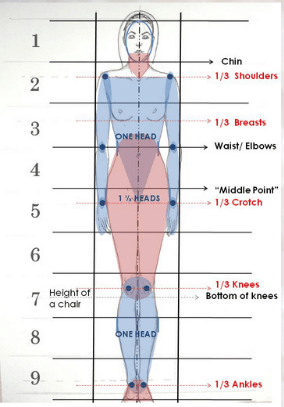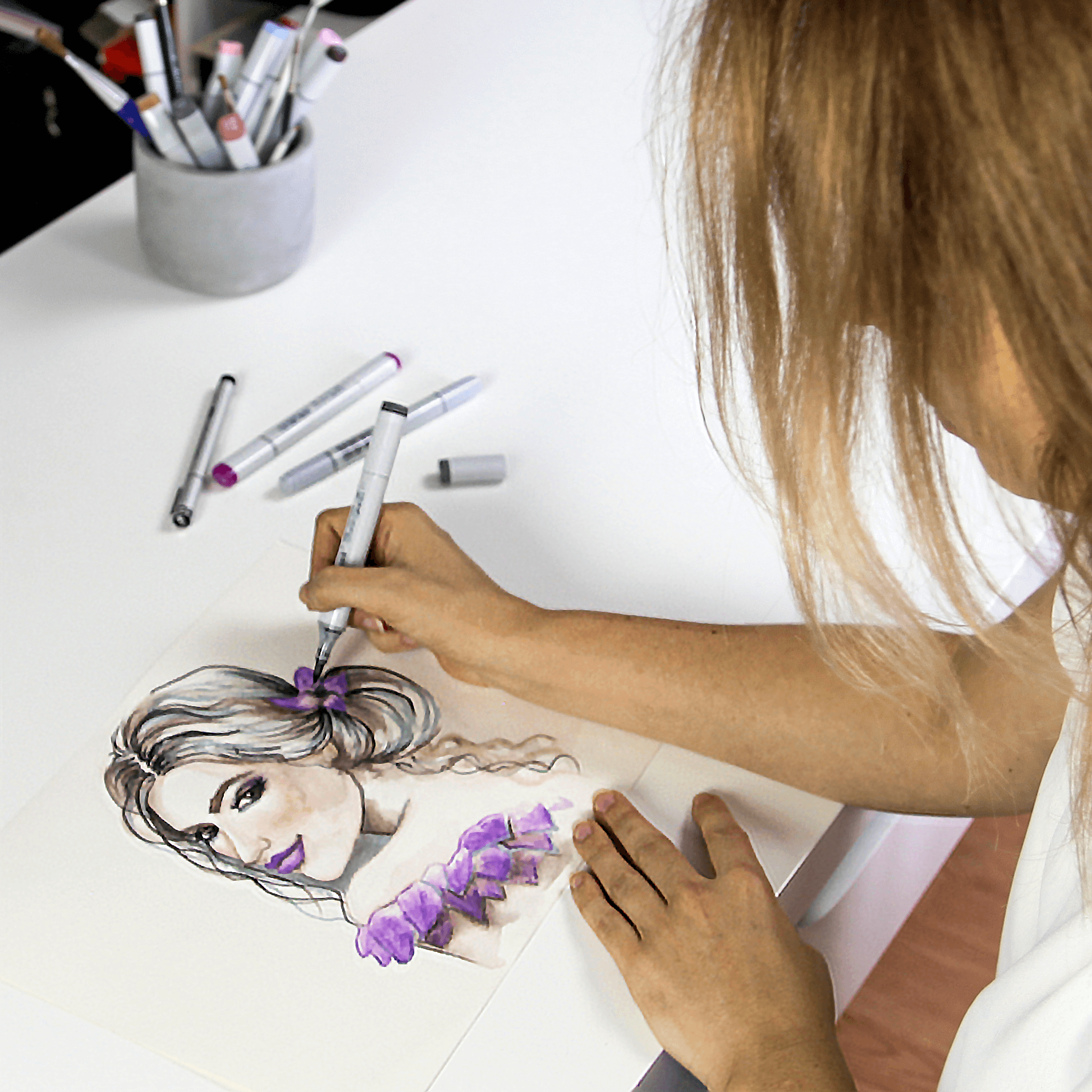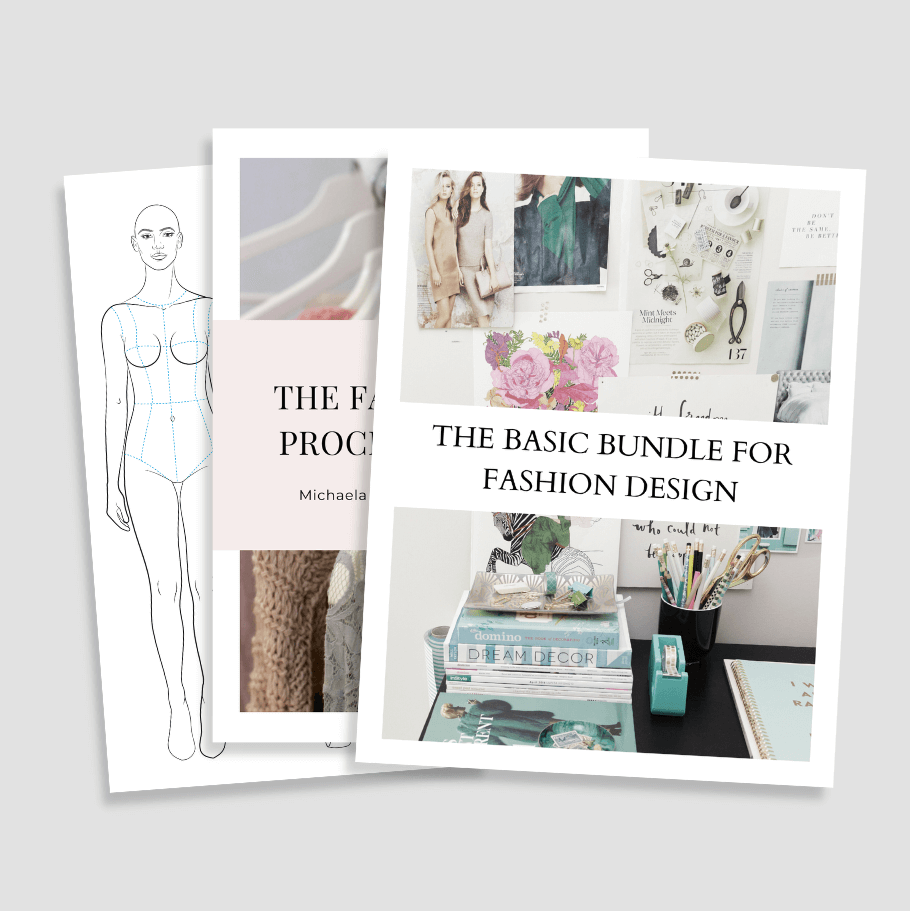Your Free Gift The Basic Bundle for Fashion Designers
Your Free Gift The Basic Bundle for Fashion Designers

In this step by step tutorial, I’ll show you how to draw the basic standing figure for your fashion sketches. It’s one of many ways to draw fashion figures and croquis in minutes, no matter if you are a complete beginner, a fashion school student, or a professional designer.
This was my very first fashion figure drawing tutorial I posted on YouTube, which became one of my most-watched videos. Back then I used a ruler and compasses to construct the figure, but you really don’t need any measuring tools to learn how to draw like a fashion designer.
The first step I start with is drawing a nine heads scale and placing a vertical line- the line of balance. The line of balance is your guide to keeping the figure centered.
Then I draw in an ellipse for the figure’s head inside unit 1. The width of the shoulders is two heads, so I mark the widest point of the shoulders with two additional vertical lines. The last thing I add is the secondary lines, which are mostly one-third of each unit. I’ll recommend labeling the marks until you know the proportions by heart.
Once the units are clear I go on with the torso. To find the location of the shoulder joints, I create a line, starting at mark 0, in about 30 degrees to the line of balance. I extend the line until it crosses mark 11/3.
At mark 3, I hint the width of the waist is one head unit and lastly, I make a cross at 4 1/3 for the crotch or pelvis.
Now all you need for the torso is to connect the shoulder joints, with the waist and the crotch.
A triangular shape is an abstract form of the figure. Later I can flesh out the body by following this shape as I add the muscles.
The crotch, pelvis, or hip line is the main division point. If you are a traditional artist or costume designer looking for a natural body, then use the eight-unit scale. In this case, the body from the pelvis up to the top of the skull will be equal to the length of the legs, with the feet in flats.
If you are but a fashion illustrator or designer, you will want to elongate the legs from the crotch down to create a nine heads figure. In this case, mark the joints of the knees at 6 1/3 .
Now I sketch a curve by starting at the waist and go outwards to create the hip and thigh until I reach the knee at 61/2. Repeating the same technique on the other side of the balance line, the hips width should be about 11/2 heads.
The width of the lower legs is about one head unit.
To draw the calves, start at the knees at mark 61/3 Draw an outwards going curve until you reach the ankles at mark 82/3.
The remaining one-third of the unit is for the feet in flats. If the model is wearing high heels, add another half of a unit for the heels.
To construct the arms you need to connect the shoulder joints with the elbows at waist level, and the wrists at the crotch level.
The hands are going then from the crotch level up to mark 5. This is the final front view of the fashion croqui.
The outline of the back view of the figure looks the same, with some differences in the muscle structure.
In conclusion, there are some rules you can follow to keep the figure in correct proportions and balance. Here is the figure drawing at one glance.
Because my drawing style has changed, I no longer use this measuring scale. Now I prefer the more elongated 10 heads figure. However, if you want a croqui with proportions close to those of a real human body, this technique is a great resource for you. Check out the video:
If you want to learn other ways of constructing a figure or what’s the difference between the different fashion proportions, read on!
And when you’re super rushed and need a fashion croqui to sketch your ideas to paper without a lot of time or work, you can grab the free Basic Bundle. It features the most essential fashion figure templates for every illustration. It’s a selection of printable front, back as well as side figure templates to help you draw professional fashion design sketches.
You can always support our efforts by checking the paid templates as well! We’ve got:
And many more.
if you liked this post, you'll PROBABLY be into these—
Business tools, art materials, equipment
You wanna see my secret weapons for running my biz and creating art? Here is a sneak peek at what’s happening behind-the- scenes at Fashion ARTventures.
This is everything I have used and loved, from my art techniques and software, to my filming equipment and platforms that help me run my biz !


THE BASIC BUNDLE is a collection of female fashion templates in the most essential poses + the fashion design process checklist and the fashion figure proportion scale for sketching the croquis freehand.
Grab your favorite paints or your iPad, put on some chill tunes, find a cozy spot, and let us take you on a journey full of ARTventures! As you color, you’ll be practicing your artistic skills, exploring color combinations, and improving your eye for design.